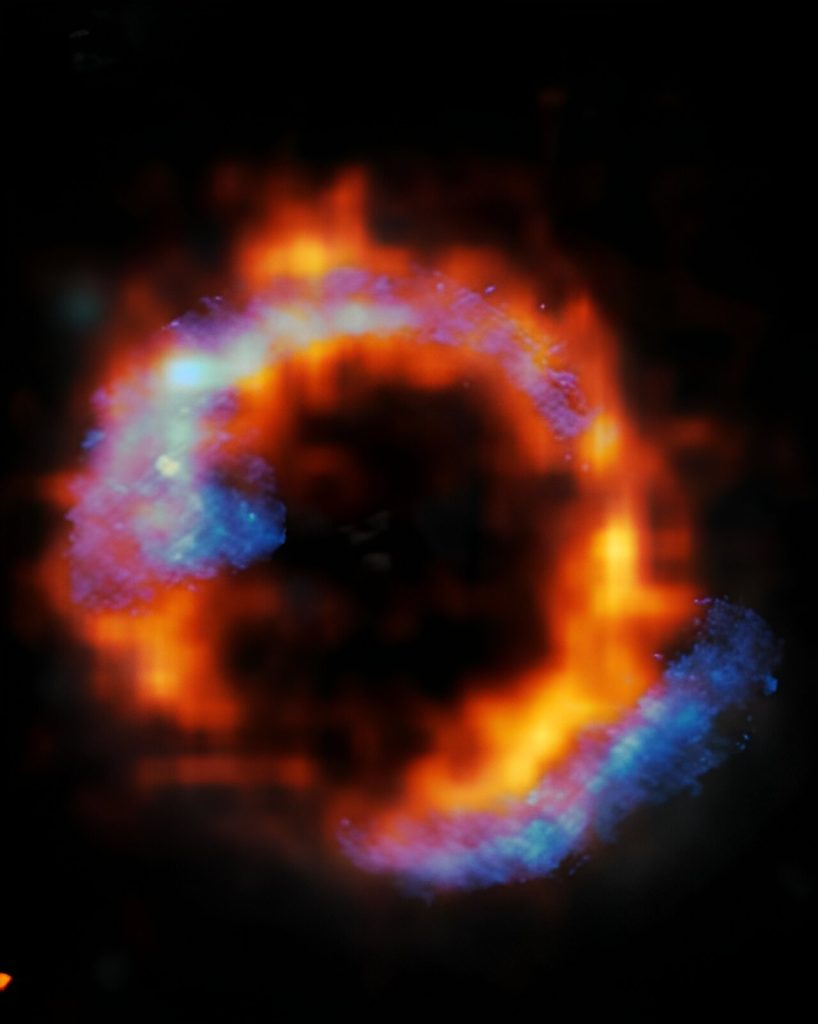Distant galaxy PJ0116-24, a Very Luminous Infrared Galaxy (HyLIRG), where cool gas is shown in blue and warm gas in red. Courtesy: ALMA (ESO/NAOJ/NRAO)/ESO/D. Liu et al.
The question of what triggers rapid star formation in Ultra-Luminous Infrared Galaxies (HyLIRGs) remains unanswered, but is of great interest for understanding the formation and evolution of galaxies in the Universe. A new photo released by the European Southern Observatory shows distant galaxy PJ0116-24, a HyLIRG that is 10,000 times more luminous than the Milky Way (in the infrared), and the newly published Published Papers in Natural Astronomy It sheds light on its formation.
Previous studies have suggested that such extremely luminous galaxies must have arisen through galactic mergers. These collisions are thought to create regions of dense gas that trigger rapid star formation. However, isolated galaxies could also become HyLIRGs through internal processes alone, if star-forming gas flows rapidly towards the galaxy’s center.
The paper, titled “Detailed study of an unusual ultra-luminous rotating disk in a 10-billion-year-old Einstein ring”, co-authored by Dr Amit Vishwas, an astronomer from Cornell University, combined observations from ESO’s Very Large Telescope (VLT) and the Atacama Large Millimeter/submillimeter Array (ALMA) to study the motion of gas within PJ0116-24.
While ALMA tracks the cold gas, which appears in the blue of the picture, the VLT with its new High Resolution Imaging Spectrograph (ERIS) tracks the warm gas, which appears in the red. With these detailed observations, the international team discovered that the gas in this extreme galaxy rotates in an organized manner, rather than the chaotic state expected after a galactic collision – a surprising result. According to the researchers, this shows that galaxies do not necessarily need to merge to become HyLIRGs.
PJ0116-24 is so far away that it took its light about 10 billion years to reach Earth. The foreground galaxy acts as a gravitational lens, bending and magnifying the light from PJ0116-24 behind it, projecting it into the Einstein rings seen here. This precise cosmic arrangement allows astronomers to magnify very distant objects and observe them with a level of detail that would be very difficult to achieve any other way.
Vishwas, a research scientist at the Cornell Center for Astrophysics and Planetary Sciences (CCAPS), helped use ALMA to map the emission and motions from PJ0116-24’s atomic and molecular gas, providing strong support for the rotating disk scenario, and was also involved in acquiring data with the VLT’s new ERIS instrument. The work was led by Daizheng Liu of the Max Planck Institute for Extraterrestrial Physics and Zifengshan Observatory.
Our interpretation of the gas state and elemental abundances of PJ0116-24 is similar to that presented by Vishwas and co-authors. Reported last year Using data from the James Webb Space Telescope, we will search for other galaxies from earlier times in the universe.
But PJ0116-24 is about five times more massive and bright than the source studied in last year’s paper, Vishwas said.
“In both cases, Gravitational lensing “It has helped us get a detailed look at the interstellar material in these galaxies, and we believe these new observations will help frame the debate about how galaxies evolve and form – how gas is efficiently transformed into stars during rapid growth separated by long periods of relative calm,” he explained.
For more information:
Daizhong Liu et al., A detailed study of a rare, ultra-luminous rotating disk in a 10 billion year old Einstein ring, Natural Astronomy (2024). Publication date: 10.1038/s41550-024-02296-7
Provided by
Cornell University
Quote: Amazing rings shed light on galaxy formation (July 15, 2024) Retrieved July 16, 2024 from https://phys.org/news/2024-07-galaxy-formation.html
This document is subject to copyright. It may not be reproduced without written permission, except for fair dealing for the purposes of personal study or research. The content is provided for informational purposes only.


